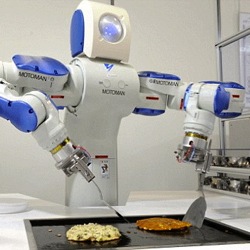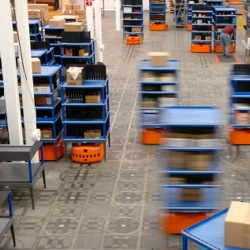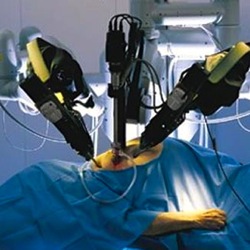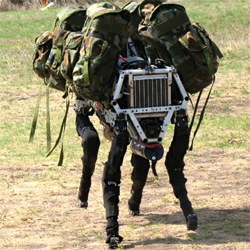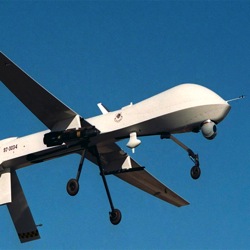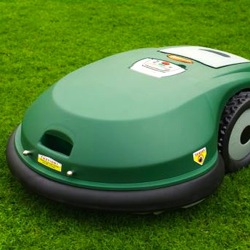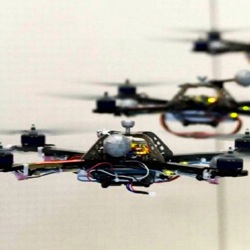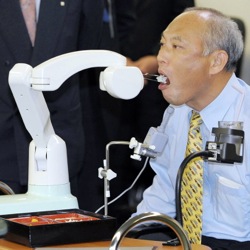I’ve recently been having many conversations with friends about Google’s driverless car and the broad implications it has for the economy and our culture.
We’ve been imagining and inventing autonomous vehicles since the 1980s. So, before this post gets too serious, let’s take a quick trip through our culture’s imaginings regarding this technology.
Imagining the future
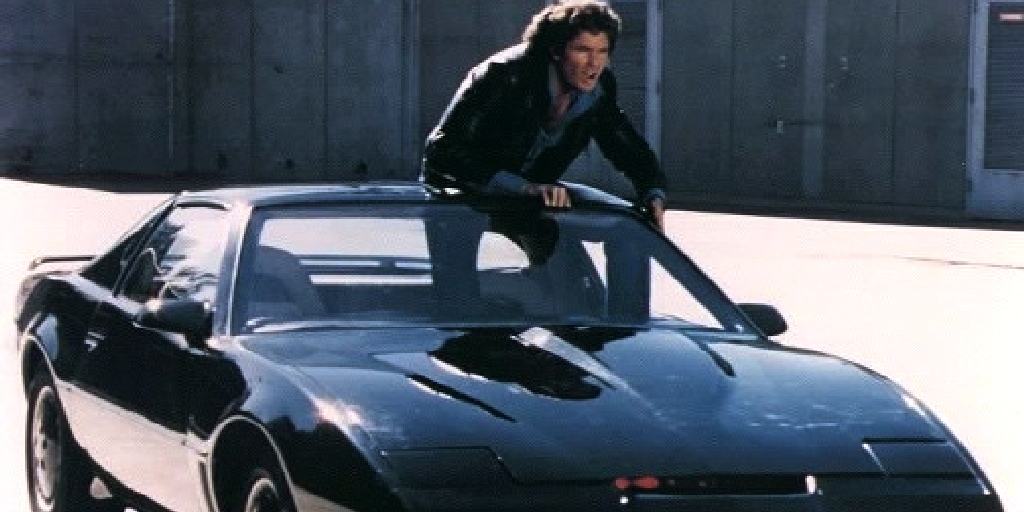
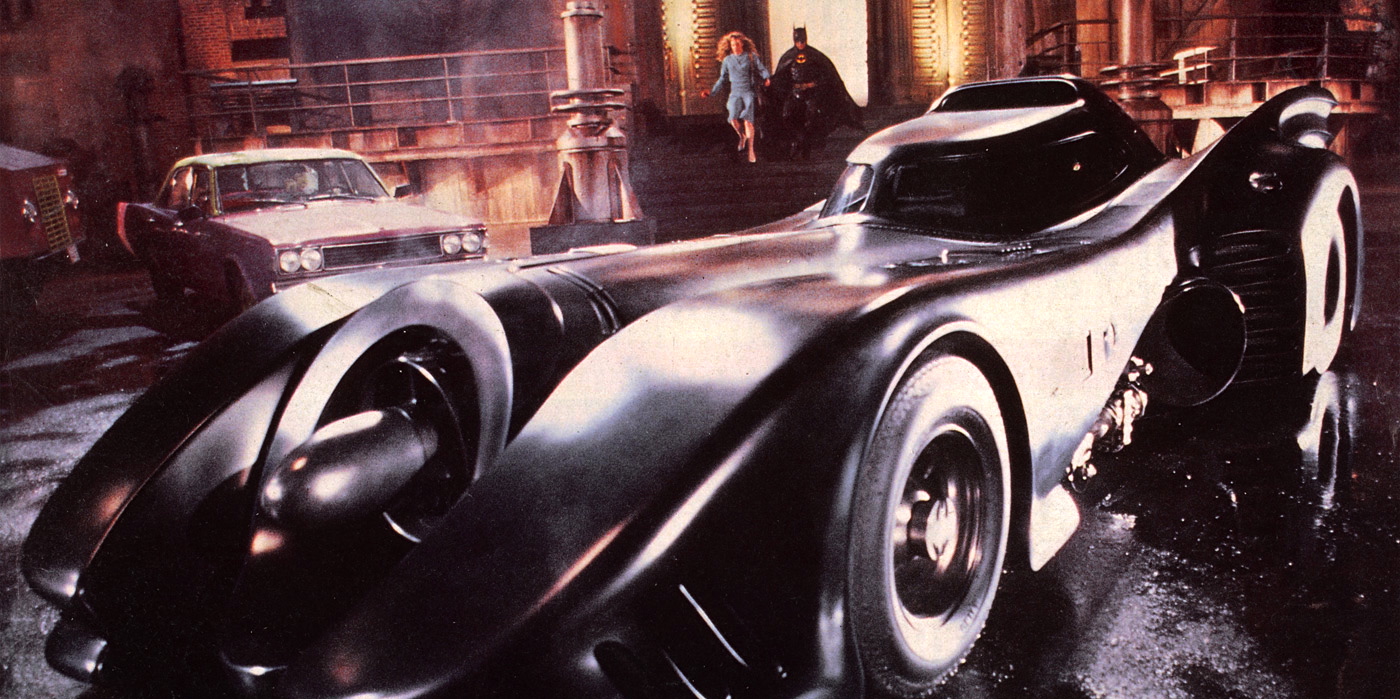
In 1982 & 1989, we thought our self-driving cars would function almost entirely like a normal car. The driver still typically works the steering wheel even though the car is perfectly capable of understanding vague voice commands and performing complex navigation and maneuvering.
Of course, Batman calling the Batmobile to pick him up gave us another idea of a potential use for this technology: taxis!
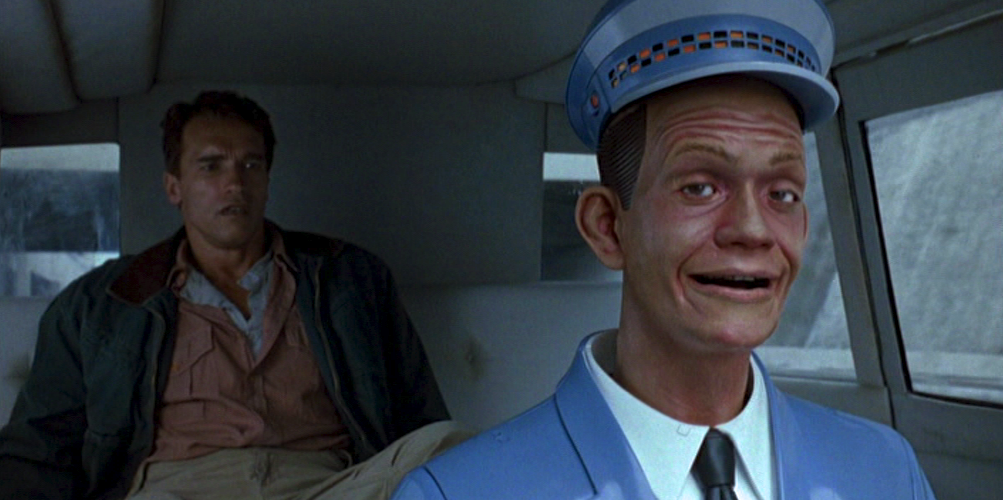
The potential for automated taxis was explored in 1990. This self-driving car even comes with a low-grade android driver, to give passengers the full taxi experience. Of course, things didn’t work out too well for either the passenger or the taxi in this case.
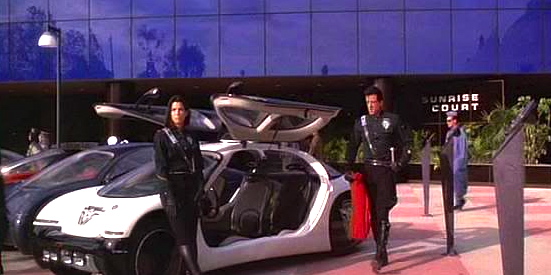
By 1993, not only was Taco Bell the only restaurant to survive the franchise wars, but it was determined that human beings cannot safely operate a motor vehicle. Stallone proved this hypothesis quite conclusively and perhaps someday we’ll see crash foam also.
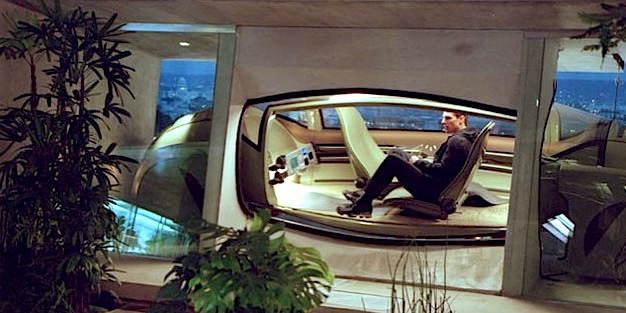
Continuing into 2002, our imagination does not evolve much. We continue to fully trust autonomous vehicles above human driving abilities. Only reckless movie protagonists would even think of driving a car by themselves, often with disastrous results.
Appreciating the present
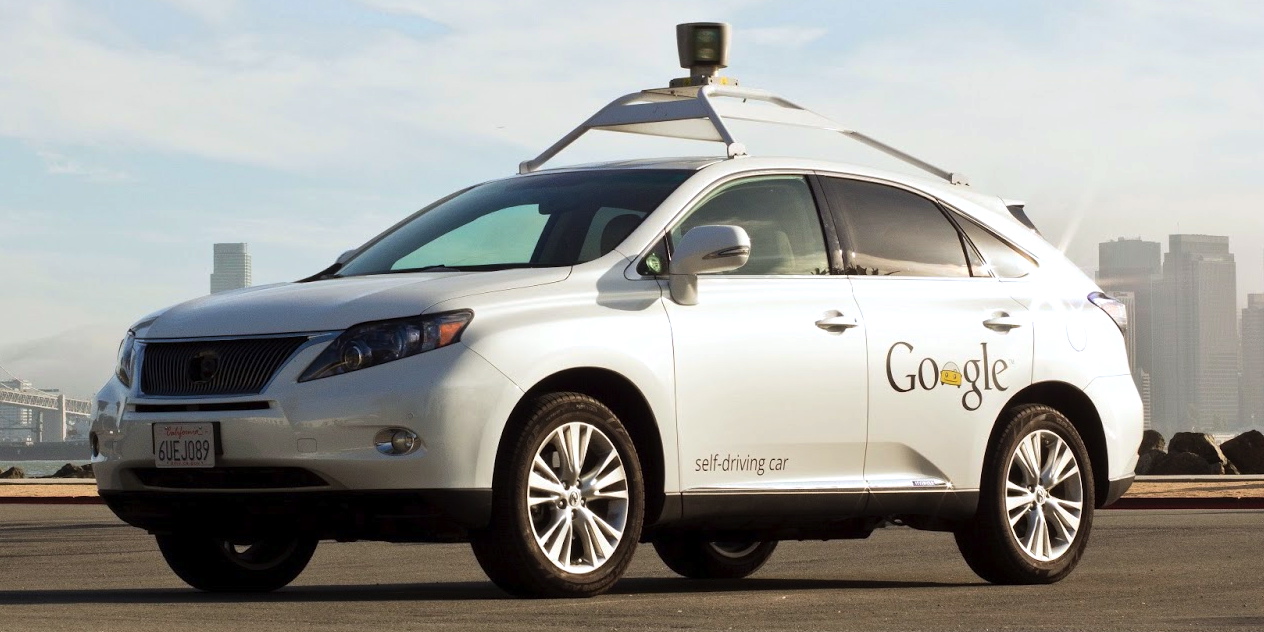
We’ll soon learn exactly how this technology is going to be used thanks to the catalyzing effect Google’s driverless car program is having. Google has given no indication of when they will bring their research to market, but that’s not slowing down the competition. Although major corporations and governments predict it may take until the 2020’s for the technology to become available, it’s never to early to think about the implications.
It’s easy to see the obvious benefits of owning your own personal driverless car:
- Read a book, catch up on email, take a nap or even (GASP!) text during your daily commute.
- Road trips are a breeze. Traveling to far off destinations becomes as easy as “set it and forget it!“
- Once all cars self-drive, about 30,000 fewer people will die each year.
But this is only scratching the surface and all of these are based on assumptions that the technology won’t fundamentally alter how we interact with vehicles. Here’s some bigger picture changes:
- If cars can safely drive closer together, our road system won’t need to be as large or complex as it is.
- Who cares about parking? Your car can go park in the cheapest lot it can find. It will know what time you like to get picked up.
- Significantly reducing traffic accidents means that we don’t need any traffic police or as extensive of auto insurance (we’ll talk about that more later).
But even these benefits are falling for the same trap of failing to appreciate how much technology can change a population’s behavior. What is the single largest effect this technology will have?
Here’s a hint: jobs.
Contemplating our future
The core problem with all the assumptions made about self-driving technology is that the focus is entirely on the private use of vehicles. There are many other categories that are worth considering. Let’s start with our “Johnny Cab” scenario.
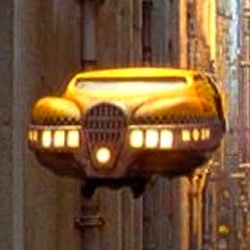
Taxi Drivers
It turns out there are just barely a quarter million jobs out there for taxi drivers. The U.S. Bureau of Labor Statistics seems to think that our economy will need an additional 47,000 of these jobs by 2020. However, let’s look at the costs. In Boston, it takes $2.84 in revenue to pay the driver $1.00 (i.e., 35% of the cost goes to the driver). New York taxi drivers report that they keep $22 out of $160 revenue (13% goes to the driver). If somewhere between 13% and 35% of the cost of operating a taxi is paying the human driver, how long until we see driverless fleets of taxis? (Especially since customer satisfaction with taxis tend to be lower than all other forms of transportation.)
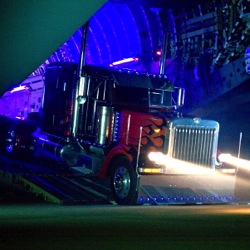
Cross country freight
It’s no secret why our locomotive system is struggling. Tractor trailers are a much more effective method of moving goods across our country. Countries need effective systems of transporting goods, and there were 1.6 million of these jobs in 2010. Turns out that, even though those jobs beat the national median wage, many of those jobs are unfilled. With trucking companies having trouble getting humans to drive the trucks, how long until they license technology to drive the vehicles instead? And, once that technology has proven itself, what happens to those 1.6 million jobs?

Bus transportation
Buses and shuttles are the backbone of the public transportation system. You may have been exposed to driverless trains before and the trend is growing. When all cars can be self-driving, why can’t buses and shuttles? Over 600,000 people currently drive a bus.
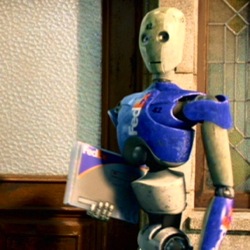
Local delivery service
With Amazon experimenting with same day delivery and other novel fulfillment techniques, one must beg the question of who will be the first company to create a fleet of short distance driverless delivery trucks? It’s not impossible to imagine that the “big three” delivery companies would have fewer headaches if they had fewer drivers. But once you’ve solved the “last mile” problem, what about the “last 50 feet” problem? Even if there’s no robotic solution and humans must still be employed to unload goods… will those jobs pay more or less than today’s delivery jobs? There are a combined total of about 213K+50K+100K = 363,000 vehicles and drivers.
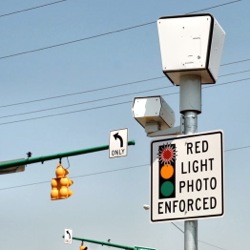
Traffic police
How many times have you heard someone complain that “cops should be out solving real crimes instead of writing speeding tickets?” Ideally, the elimination of traffic related incidents should free up police to do a better job patrolling neighborhoods and fighting “real” crimes. But in an era of strapped government budgets, it’s more likely that some significant portion of the 800,000 police jobs will simply no longer exist.

Automobile insurance
With annual revenues of ~$160B (with a “B”) and around 300,000 employees, the automobile insurance industry is designed for a dangerous human-operated vehicle world. When accidents stop happening, there will be less work for adjusters, less repair work, and lower premiums. Less premiums means less room for profit. In the endgame analysis, will private individuals carry their own insurance or will manufacturers simply carry slightly expanded product liability policies?
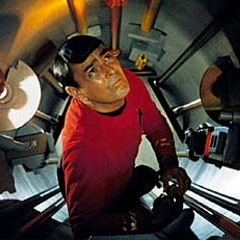
Automobile repair
While driverless cars will still require maintenance and will still experience mechanical failures, there is certainly some portion of that which is a result of poor driving practices. Our country employees over 700,000 mechanics who are, in part, performing repairs on the 10.8 million motor vehicle accidents each year.
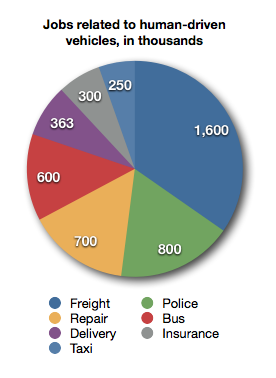
Ripple effect
Every job in America creates additional jobs. Although we’ve already discussed a potential disruption of up to 4.6 million jobs, the true impact could be even greater. Having that many jobs evaporate is significant.
In 2001, the U.S. government spent $15 billion dollars to rescue the airline industry when, at the time, it employed ~625,000 employees. The financial industry sector (the one that’s “too big to fail“) employs 5.7 million employees.
What else will change?
What else could be affected with driverless technology? Here’s some more fanciful ideas that have come up in recent conversations.
- Refueling and oil changes If your car can drive itself, why not send it out while you are at work or asleep to be serviced? There may be a temporary explosion of gas station attendant jobs — of course, they’ll all be pumping gas into cars with no drivers. No drivers to run inside the store and buy drinks, snacks, or lottery tickets which are the primary sources of profit for gas stations. This also means that smaller automated refueling stations (much like drive-thru ATMs) placed off of main thoroughfares could entirely replace high-rent corner lot gas stations.
- Ride sharing Most of the time, your personal vehicle sits in a parking space either while you work, shop, or sleep. If you could register your vehicle for a ride sharing service and let your car generate revenue for you, would you do it? The main objection I’ve heard to this idea is the potential for abuse by renters. But with a credit card on file, a reputation system (like eBay), and in-vehicle cameras (your self-driving car will already have cameras, why not add a few that point inside?), what’s the risk?
- Fewer cars on the road If automatic taxis are plentiful and inexpensive… if public transit is more efficient… if there is a cultural shift against the act of driving itself… then at what point does private vehicle ownership cease to be the norm in American culture? It may only be that, like private planes, it becomes typical only for the wealthy to own their own vehicle.
- Proliferation of vehicle styles Why are vehicles designed the way they are? In almost all cases, the first priority for vehicle design is driver and passenger safety and comfort. In an automated vehicle system, what percentage of vehicles even need a human driver or passenger at all? Amazon’s fleet of self-driving delivery vehicles may simply be a bank of weather proof lockers, with compartments that pop open when the recipient taps an “accept delivery” button on their iPhone.
Embracing change
If you’ve read this far and you think I’m somehow against the approaching driverless revolution, you’re wrong.
I raise these points for a few reasons. First, if you are planning a career in any of these professions, take a moment to reflect on how long humans will be involved. (Of course, if you want a long-term career, you may want to look into the robotics and automation fields.)
Second, I think there may be many opportunities in this coming landscape to create value in unexpected ways. Technology focused individuals often get more wrapped up with software innovations, but there are still a lot of real-world challenges and opportunities.
Third, I think that the time will come in the next decade to have a conversation about why, precisely, we pursue the advancement of technology. We’ve had similar crises in the past with the Agricultural Revolution, Industrial Revolution, Microcomputer Revolution, and the Digital Revolution. Self-driving cars may be the technology that ushers in the Robotics Revolution, but it won’t be the last. We’ve already imagined futures where robots are pilots, cooks, police officers, surgeons, and more.
If we humans create that future, what “work” will be left? If humanity is no longer involved in the production of goods or services, what does that mean for our culture and economy?
How long can we continue the trend of adding value to existing products and services? Will we reach a point when “new features” are no longer possible or desirable?
Will we create a dystopian future with crass faux-commercialism to try to sustain an illusion of work?
Will a “page view economy” or “click economy” come to dominate the economic landscape?
These are conversations worth having, online and off, with anyone who wants to be a part of shaping our future.
